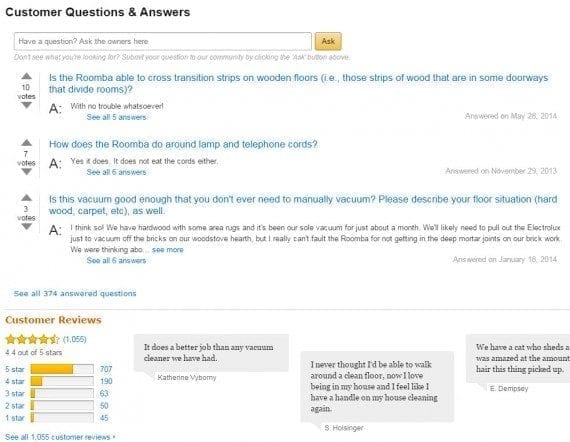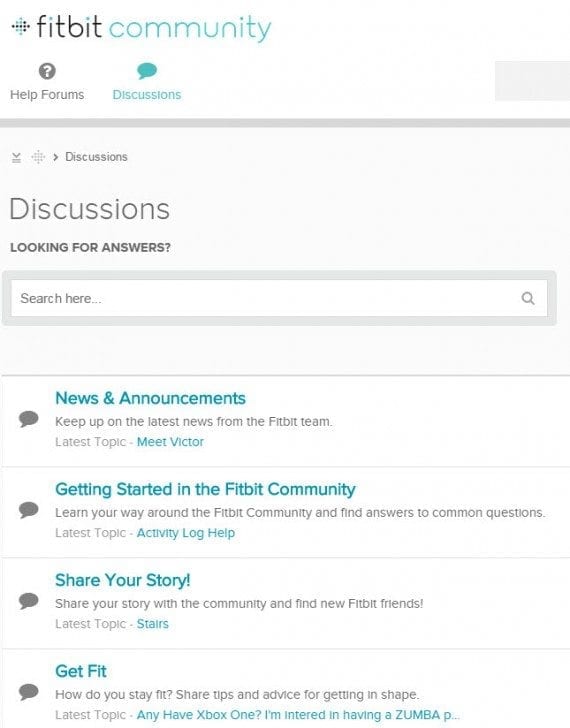When it comes to ecommerce, not all sites are created equal. The successful ones listen to existing and potential customers, and provide the information necessary to make an educated decision.
Supporting content is key for any online store. Such content includes (but certainly isn’t limited to):
- Customer reviews and discussions;
- Product help and FAQs;
- How-tos;
- In-depth specifications (sizes, output values);
- Recommendations;
- In-use product videos, blog posts, or articles;
- User forums.
Supporting content also helps e-tailers trump brick-and-mortar stores, which rely instead on the knowledge of staff members on duty while shoppers peruse items. Whether you sell a variety of products, or only products your company creates, answering questions is the best way to help close a sale — even if someone else answers them for you.

While it is the manufacturer of the product it sells, Fitbit (which sells wearable devices to monitor health and fitness) focuses on community and extensive documentation to help sell. All of this information is visible to the public, whether they buy directly or not.

Shoppers can read Fitbit’s community discussions, or peruse all the help files, before choosing to buy.
How a product is used plays a big role in someone’s decision to buy. When shopping online, consumers cannot open a box to read instructions. Instead, PDF files of manuals and troubleshooting docs, as well as realistic videos, can help answer questions.

Along with specs and customer reviews, Panasonic provides the complete user manual pre-purchase — see “Owner’s Manuals” at lower left, above.
If you’ve ever been stuck with asking an unknowledgeable store associate just how well a product does its job, you know how frustrating it is for online shoppers when it comes to researching and buying.
Providing space for users to discuss products not only helps close sales, it also helps prevent sales of items that would otherwise be returned.
Don’t confuse customer Q&A with customer reviews. While reviews may answer some questions, a question-and-answer section makes it easier for shoppers to get specific responses. A Q&A section is also helpful when a product has hundreds or thousands of reviews, since you cannot expect shoppers to read through them all.

Amazon features a “Questions & Answers” section for each product it sells. It allows customers to help each other find the best solution, even if it’s not the product in question.
Product comparisons summarize information, but they also help consumers focus on critical features when it comes to deciding between, say, five different products that perform similar tasks.
Forums are standalone discussions, but dialogue may link back to specific pages in the store. They can help current customers convince potential customers to make purchases. They also help users troubleshoot issues with their purchase.

Fitbit allows users to discuss both product-specific and product-related issues. Since non-Fitbit users can also sign up, those considering a Fitbit device can see what the company’s users have to say.

By allowing shoppers to compare its shavers, Panasonic can better serve someone looking for a 4- or 5-blade shaver, or one that can be used in the shower.
A blog is appropriate for most product lines, and gives you the opportunity to get more personal with shoppers. This type of supporting content isn’t so much about making hard sells as it is about instilling trust in the company and building a relationship with the customer. Content can include products, but it can also include articles and ideas that are relative to the product line.

Since many users of Fitbit are trying to lose or maintain weight, topics about foods, drinks, and daily activities cater to the company’s target audience.

RetroPlanet.com’s DIY blog caters to those who like to decorate in vintage style. Some posts feature products that Retro Planet sells, but many do not.

This how-to post explains in detail how to paint RetroPlanet.com’s virgin script signs. It goes beyond the product page with step-by-step instructions.
The best thing about supporting content is that it can be linked from product and category pages, and it can also stand on its own, which can help in both search engines and in generating additional product interest. While it is supplemental to the catalog, it can be a key factor in upping the time that visitors spend on a site, as well as overall conversions.
If you plan to provide supporting content to your existing store — and you should — don’t forget to provide proper navigation back to related pages, as well as appropriate discussion boxes and social links.





